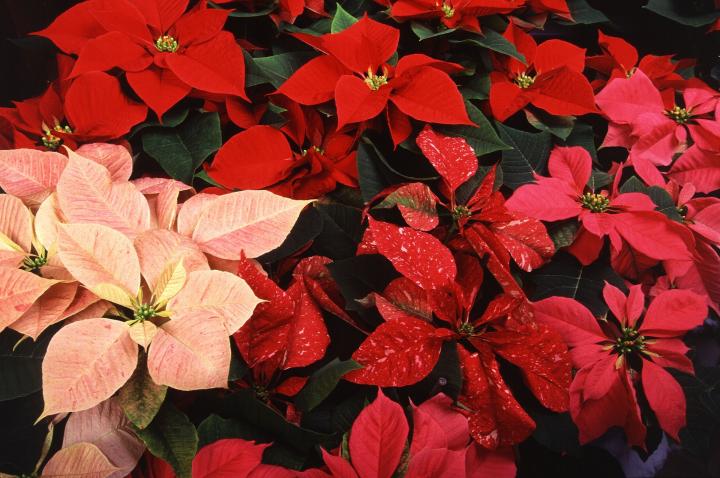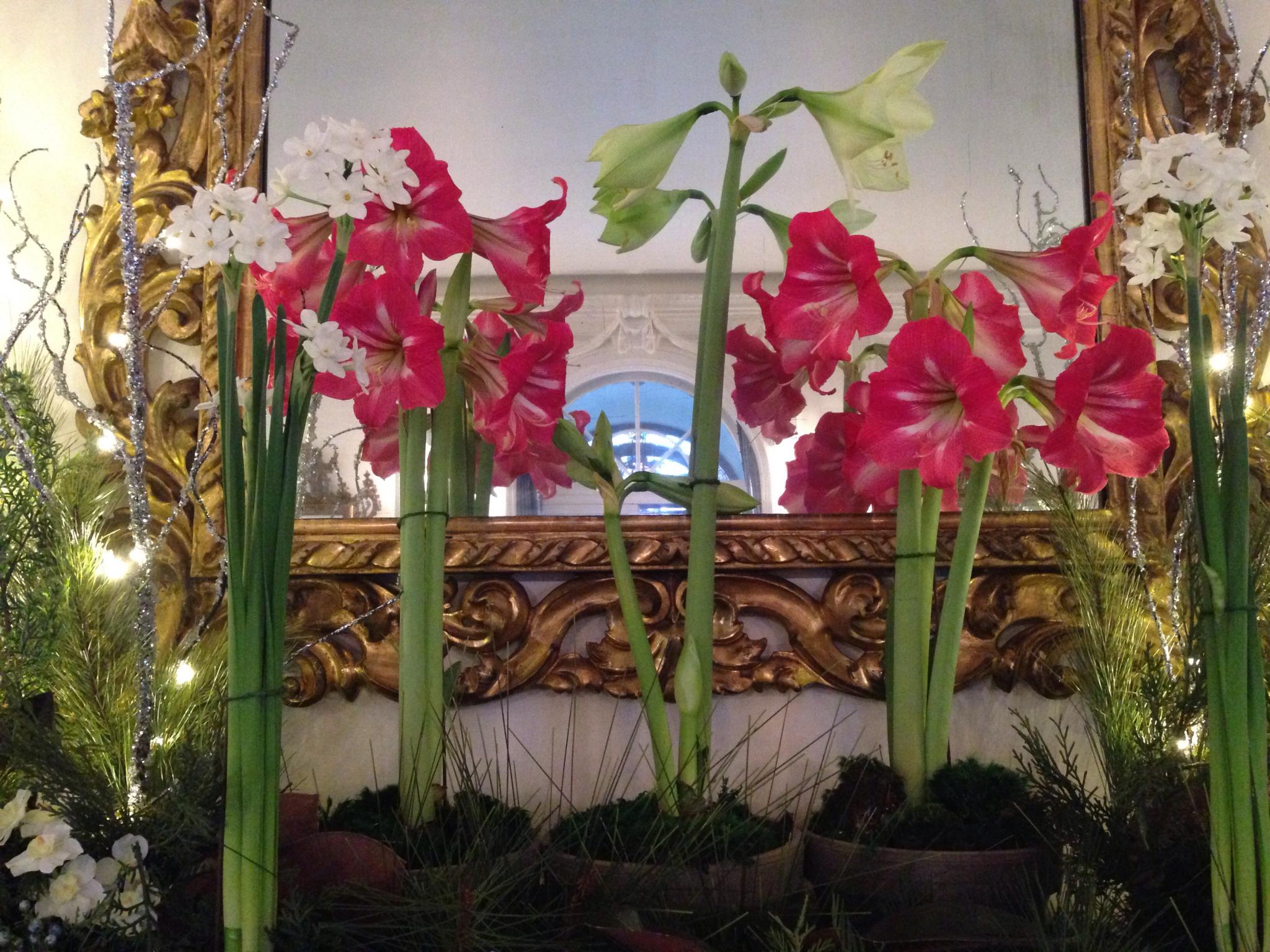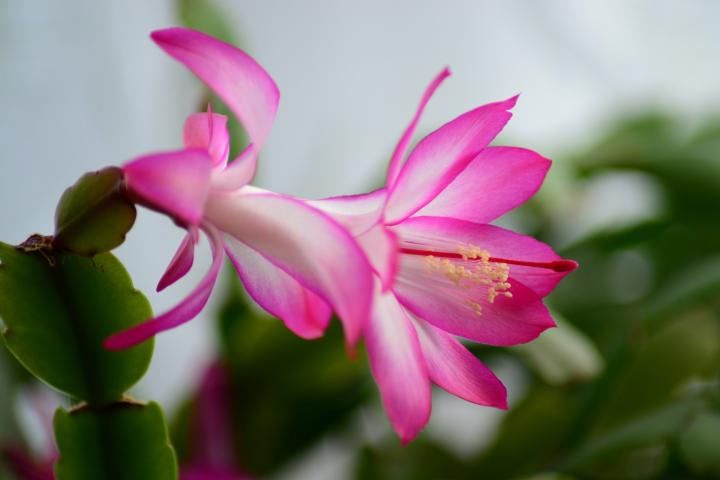Popular Christmas plants—such as poinsettia, Christmas cactus, and amaryllis—add festive cheer to any home. Let’s talk about how to care for these festive flowers to keep them blooming over the holiday season and well into the new year!
The Poinsettia
No plant symbolizes Christmas quite like the poinsettia, especially the ruby-red variety. It might surprise you to learn that the red blooms are not the flowers; they are bracts or modified leaves! It’s an unlikely Christmas plant, since it’s native to Mexico, but it flowers during their winter and has become associated with the winter holidays.
We’re going to blunt here: As poinsettias are tropical plants grown in greenhouses, they may not be easy to get to rebloom.
But let’s start by taking care of this holiday gift so it looks its best and, if we’re lucky, we’ll encourage it to rebloom, too! If need be, mark these steps on your calendar:
- Through March, just water your poinsettia as usual.
- In early April, decrease watering. The soil needs to get very dry between waterings, however, don’t let the stem shrivel up!
- In late April (two weeks later), move your poinsettia to an area with no sunlight for about 12 to 15 hours every night and keep the plant at 60 degrees Fahrenheit.
- In May, cut back the stems to about four inches. Then, repot the plant in fresh potting soil (not regular soil). Move back into a well-lit window again and start watering. At this time, start fertilizing at two-week intervals.
- When nighttime temperatures no longer fall below 50°F (10°C), move the pot outside into a partially shaded location. Keep watering and fertilizing.
- Starting in July, pinch back each stem about an inch to keep the plant bushy and compact. Continue pinching new stems, leaving three to four leaves on each branch.
- In mid-August, it’s time to move the plant back inside, to a well-lit window. Keep watering and fertilizing.
- Starting in early October, to initiate flowering, the poinsettia needs long nights in complete darkness. Cover the plant with a cardboard box or keep it in a closet from about 5 p.m. to 8 a.m. and water sparingly. During the day, bring it back out to the window.
- In early December, when buds form, stop the dark treatment.
- In mid-December, stop fertilizing. Your plant should be blooming again! If not, don’t give up hope. You still have a nice houseplant. It may bloom next year.
Get more tips on caring for poinsettias.

The Christmas Cactus
The Christmas cactus has become the recent favorite of the Christmas plants. It’s a succulent houseplant with petals that bloom in a kaleidoscope of colors including red, white, pink, cream, and fuchsia.
Why are Christmas cacti becoming so popular? Long-lived, they may produce bountiful blooms for 20 to 30 Christmases to come!
You can force a Christmas cactus into bloom in much the same way as a poinsettia (see above), by providing long nights starting around October 1. You can also persuade it to flower by subjecting it to cool night temperatures of 50° to 55°F (10° to 13°C) starting in early November.
Be sure your efforts are not in vain, though: Your Christmas cactus could be a different holiday cactus, accustomed to blooming at another time of year.
Get more tips on caring for Christmas cacti.
The Amaryllis
Although amaryllis can be purchased at any stage of development, for many, the real fun is growing their own plant from a bulb. Most amaryllis bulbs are sold already potted and with complete growing instructions. Once watering is started, you can expect magnificent, lilylike blooms of red, pink, white, or orange in four to six weeks.
If you receive one of these slender beauties this season, don’t toss the pot once the flowering ends. After flowering, grow the amaryllis as a foliage plant until the leaves turn yellow.
Then store the potted bulb on its side in a cool, dark room or basement to rest for eight to ten weeks. When new growth appears, repot the bulb and return it to the light to start the cycle again to put on another show!
Get more tips on caring for amaryllis.

The Cyclamen
There’s one more Christmas favorite that’s been popping up in stores recently—the cyclamen plant! With upswept petals and pretty foilage, the cyclamen comes in cheerful red as well as white and pink. Learn more about cyclamens.

When you display your Christmas plants, make sure they’re placed away from drafts and positioned in a bright room, but not in direct sunlight.
All of these Christmas plants prefer 60° to 70°F (16° to 21°C) temperatures and like moist but not soggy soil. As with many of us, these colorful plants will look forward to next year’s holiday season!
The Christmas Tree
And of course, there’s the Christmas tree! There’s something special about a fresh-smelling tree. Just make sure you buy from a sustainable Christmas tree farm that replants their trees just like any other crop. The best-selling evergreens come Christmas time include Balsam, Douglas and Fraser firs. And don’t forget to recycle that Christmas tree when the holidays are over.
From trimming the trunk to making sure your Christmas tree has plenty of water in its first 48 hours, be sure to check our tips on caring for the Christmas tree!











